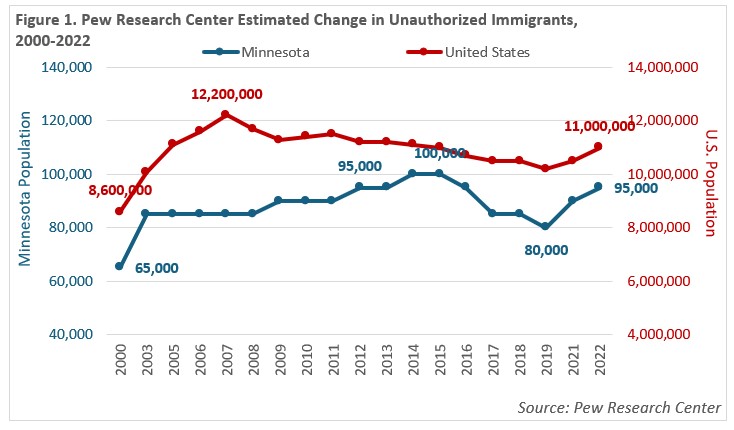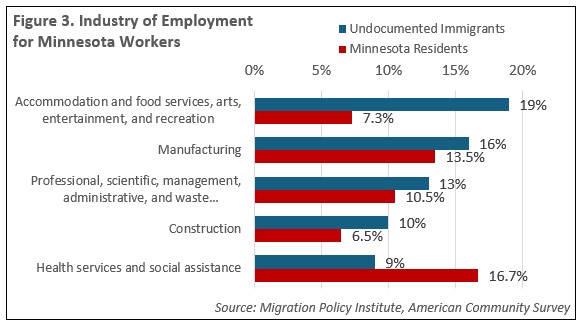
by Cameron Macht
March 2025
Minnesota's undocumented immigrant population is a small and important – but also difficult to measure – component of the state's demographic and economic landscape. Estimates of this population vary due to challenges in data collection and reporting, leading to uncertainty about exact numbers. This article aims to present an overview of the available data on immigrants in Minnesota who are undocumented, drawing from reputable nonpartisan sources including the Pew Research Center, the Migration Policy Institute, the Center for Migration Studies and the American Immigration Council, with additional context on foreign-born residents from the U.S. Census Bureau's American Community Survey.
On the high end, the Pew Research Center estimates that Minnesota was home to 95,000 immigrants who were undocumented in 2022, which would be just over 1.5% of the state's total population (5.7 million). In comparison, Pew estimates that they represented 3.3% of the total U.S. population, meaning Minnesota has less than half of that percentage. Pew suggests that Minnesota peaked at around 100,000 in 2014 and 2015, then the number of immigrants without authorization dropped through 2019, then experienced another recent increase (but with a margin of error of +/- 20,000 people). While there have been fluctuations over time, the estimate of 95,000 residents in 2022 was identical to their estimate in 2012. Long-term, both Minnesota and the U.S. as a whole have seen a significant increase in the foreign-born and undocumented population over the past two decades (Figure 1).

Similarly, the Migration Policy Institute (MPI) estimated Minnesota's immigrant population without documentation at 81,000 people using 2019 American Community Survey and Department of Homeland Security data, which matches closely with the Pew Research Center estimates for that same year, or falls within the margin of error (+/- 20,000 people) in the most recent year. On the lower end, the Center for Migration Studies (CMS) estimated about 78,000 undocumented immigrants in 2022, down from 97,500 in 2012, and the American Immigration Council estimated 73,200 undocumented immigrants in Minnesota, which is the lowest count of the listed sources.
 At a more detailed level, the MPI reports that this population is relatively well-established in the state, with 59% (48,000) having lived in the U.S. for 10 years or more, compared to 26% (21,000) that have lived here for less than 5 years. Likewise, CMS suggests that half (49.9%) have been in the U.S. for 10 or more years, and 27.2% have been here for less than 5 years.
At a more detailed level, the MPI reports that this population is relatively well-established in the state, with 59% (48,000) having lived in the U.S. for 10 years or more, compared to 26% (21,000) that have lived here for less than 5 years. Likewise, CMS suggests that half (49.9%) have been in the U.S. for 10 or more years, and 27.2% have been here for less than 5 years.
Figure 2 shows that based on region of birth, nearly 60% (47,000) of undocumented residents are from Mexico and Central America (notably El Salvador and Guatemala), well ahead of Asia (15%; 12,000), Africa (14%; 11,000), South America (8%; 6,000) and others (5%; 4,000). Similarly, CMS suggests that Mexico (35,167 residents) is the top country of origin, followed by India (5,184), El Salvador (4,006), Nigeria (3,871) and Guatemala (3,729).
MPI estimates that there are 5,000 immigrants without documentation from 3 to 17 years of age enrolled in school, comprising less than 0.6% of the state's public school enrollment (845,000 students). CMS estimates 10,176 people from 5 to 17 years of age, which would double that percentage, but doesn't say how many are enrolled. For 18- to 24-year-olds, MPI says another 5,000 undocumented immigrants are estimated to be enrolled in school, or about 2% of enrollment in this age group. As a group, 42% of undocumented immigrants aged 25 years or older have less than a high school diploma, and another 23% have a high school diploma or equivalent. In comparison, only 6% of all residents in Minnesota had less than a high school diploma, and about 25% stopped with a high school diploma or equivalent, meaning undocumented immigrants were more than twice as likely to have a high school diploma or less. However, MPI also estimates that more than one-third of undocumented immigrants have some college or an associate's degree (13%) or a bachelor's degree or higher (22%).
According to MPI, the age distribution shows a predominantly working-age population, with 88% of undocumented immigrants between the ages of 16 and 54, compared to only about 50% of the state's total population. In contrast, only 6% of the undocumented immigrant population is under 16 years of age, compared to nearly 20% of the total population. Likewise, the percent aged 55 years and over was also very different, with only 6% of undocumented immigrants aged 55 years and over, compared to just over 30% of the population overall.
 The Pew Research Center estimated that there may be 70,000 unauthorized immigrants in Minnesota's labor force in 2022, which would be as much as 2.2% of the state's total labor force (3.1 million workers). Pew reports that the Manufacturing industry has the highest number of unauthorized immigrant workers, while Agriculture has the largest share. MPI data are similar, showing the top industries of employment for undocumented immigrants include Accommodation & Food Services and Arts, Entertainment & Recreation (19%; 10,000), Manufacturing (16%; 8,000), Professional & Business Services (13%; 7,000), Construction (10%; 5,000) and Health Services & Social Assistance (9%; 5,000), with no detail for Agriculture (Figure 3). CMS estimates around 50,000 undocumented workers in Minnesota's labor force, with about one-quarter employed in Services, another 23% in Management, Business, Science & Arts and 22% are in Production, Transportation & Material Moving occupations.
The Pew Research Center estimated that there may be 70,000 unauthorized immigrants in Minnesota's labor force in 2022, which would be as much as 2.2% of the state's total labor force (3.1 million workers). Pew reports that the Manufacturing industry has the highest number of unauthorized immigrant workers, while Agriculture has the largest share. MPI data are similar, showing the top industries of employment for undocumented immigrants include Accommodation & Food Services and Arts, Entertainment & Recreation (19%; 10,000), Manufacturing (16%; 8,000), Professional & Business Services (13%; 7,000), Construction (10%; 5,000) and Health Services & Social Assistance (9%; 5,000), with no detail for Agriculture (Figure 3). CMS estimates around 50,000 undocumented workers in Minnesota's labor force, with about one-quarter employed in Services, another 23% in Management, Business, Science & Arts and 22% are in Production, Transportation & Material Moving occupations.
Looking at total employment in those industries, these MPI estimates suggest that undocumented immigrants may hold about 3.5% of total jobs in both Accommodation & Food Services and Arts, Entertainment & Recreation (3.6%) and Construction (3.5%), as well as 2.5% of Manufacturing, 1.8% of Professional & Business Services and 1.0% of Health Care & Social Assistance employment.
The American Immigration Council estimates some other contributions from undocumented immigrants to Minnesota's economy, including significant tax revenue, with annual tax contributions nearing $500 million. Of this amount, nearly $180 million goes to state and local governments, and $308 million to federal taxes. The economic contributions of Minnesota's undocumented immigrant population also extend beyond tax revenue. Immigrant households generate $2.2 billion in annual household income and have spending power of $1.7 billion (Figure 4).

Immigrants contribute across all aspects of Minnesota's economy, from education to the labor force to consumer spending. Though imperfect and incomplete, data show that unauthorized immigrants play a small but important role in our current workforce, with participation in major industries and occupational groups across the state. Immigrants influence Minnesota's businesses, communities and economic activities, particularly as the state addresses ongoing demographic shifts and labor market needs, helping to create a diverse labor pool that fills critical gaps in both high-skilled and service-oriented sectors. For more information, read DEED's new article on the foreign-born workforce and our reports on the Importance of Immigration.